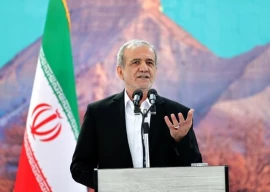
The state of education in Balochistan remains appalling, even by our national standards.
The Pakistan Social and Living Measurement Survey 2011-12 puts the country’s literacy rate at a “stagnant” 58 per cent, with Balochistan standing at 46 per cent. The gender breakdown is also worrying, as 65 per cent passing the literacy test are male, while only 23 per cent are female. Moreover, the Annual Status of Education Report 2013 stated that only about 24 per cent of third graders in the province can read a sentence in Urdu, while only 22.2 percent can do simple subtraction.
According to the National Plan of Action compiled by the Ministry of Education, about 500,000 children are out of school in Balochistan, while a total of 1.09 million students are enrolled in 1,200 private and government schools. The primary completion or survival rate in Balochistan is 53 per cent.
Advisor to the Balochistan Chief Minister on Education Raza Muhammad Barrech has been exerting efforts towards improvement of education sector. He stayed in Islamabad for almost a week to persuade and cajole international donors to invest in Balochistan’s education sector which, according to him, needed comprehensive and consistent efforts for revival.
Talking to The Express Tribune, Barrech said, “Access is the biggest issue for us in the province, as about 10,000 [settled areas] out of 22,000 have no schools. Poor communication infrastructure is another big hurdle.”
Adding on, Barrech informed that the government has decided to enrol about 1.3 million students by 2016, the development budget for which will be Rs978 million, and the recurring budget requirement Rs294 million.
Another challenge is the low population density, stated Barrech, explaining that the province covered almost 44 per cent of the country’s land mass while housing only 5 per cent of the population, with some villages made up of just over five households.
This is why the survival of students is a challenge, as schools cannot be constructed for such a small populations and parents hesitate in sending their children far away for education, he said.
Education, Trainings and Standards in Higher Education Secretary Ahmad Bakhsh Lehri, who himself hails from the province and has also served as its chief secretary, commented that some areas still do not have electricity. “Awaran and Kakar Khorasan are yet to be connected with the national grid. In such a scenario, how can one expect to educate children and increase enrolment rates,” lamented Lehri.
According to Barrech, the province has been unfortunate on the education and literacy front for many reasons. For instance, Persian was the official language in 80 per cent of the province until 1958. Consequently, a huge chunk of the population was rendered ‘illiterate’ when Urdu became the national language. Meanwhile, the first university in Punjab was built in 1884, while in Balochistan the development was delayed until 1970. “Prior to 1970, educational institutions here were affiliated with the Multan Board. This should give a fair idea of the dismal picture,” he added.
About revamping education, Barrech said they have targeted 300 schools for upgradation from the primary to middle level, and approximately the same number from middle to high school level.
Recently, the education department also compiled a Balochistan Education Sector Plan, announcing the recruitment of about 57,000 new teachers and the initiation of comprehensive training and refresher programmes, for the implementation of National Education Policy 2009. Moreover, a few months back the government passed Article-25-A of the constitution, which makes it binding for it to provide free and compulsory education to all children from the ages of five to 16.
Barrech informed that they were preparing a monitoring and assessment system for coding and mapping of all the schools, students and teachers to keep track of transfers or drop-outs.
He also stated that about 300 schools have been vacated in the last few months by politically influential persons for personal use, a practice that would continue in the future.

Although the province has six varsities, Barrech busted the myth of quality and the history of their establishment. He said none of the varsities were planned --- University of Balochistan started in a building for the Government College for Mining and Technology, Balochistan University of Information Technology and Management Sciences (BUITMS) functions in the Baleli Textile Mills building, and Sardar Bahadur Khan University is housed in a former tuberculosis treatment centre.
Talking about financial issues of the varsities, Barrech stated that University of Balochistan and others were facing financial problems. “We have not yet contemplated establishing our own higher education department like other provinces did,” he added.
Lehri concluded by saying that a programme for Balochistan needs to be formulated in order to give education in the province a push towards the right track and create an environment conducive to learning.
Published in The Express Tribune, February 17th, 2014.

















COMMENTS
Comments are moderated and generally will be posted if they are on-topic and not abusive.
For more information, please see our Comments FAQ